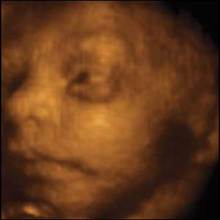Football wasn’t the only thing on the tube yesterday as I found myself pulled away from ESPN and NFL Network game highlights to watch the National Geographic Channel’s program, “In the Womb: Animals.” Using the latest 4D ultrasound imaging, state-of-the-art cameras and computer graphics the 2-hour program took us through the stages from conception to birth of yellow labradors, elephants and dolphins as they developed in their mothers’ wombs.
The elephant goes from a single cell to a 260+ pound “baby”; the dolphin learns to swim before it is born and the dog also showed full-grown dog behavior while still in utero. The film work, showing color and movement, is spectacular and engrossing (and sometimes just gross, based on some of the Mall Diva’s reactions). When you see the amazing close-ups and sharp detail of these developing species it is impossible not to think about the implications if the National Geographic Channel should devote the same study to comparable stages of human babies — pardon me, fetuses. As I watched the program I even thought outloud how great it would be if they used the same technology to cover human development, but I figured that would be anathema to contemporary thought and too controversial. Still, I was happy that this program was available as it couldn’t help but make anyone watching it pause to think.
I was therefore pleasantly surprised — nay, thrilled — to learn that NGC in fact had already kicked off their series back in November with a study of human infants in the womb, and is planning to carry another “In the Womb” program in January featuring the development of human twins (maybe even triplets), including film of the unborn children playing, fighting and cuddling. (More details here). I’m definitely going to check my listings for repeats of the first show and the broadcast schedule for the upcoming one.
The footage in these programs is absolutely devastating to the “blob of tissue” arguments that persist mainly because people don’t want to — or haven’t been able to — see the truth for themselves. There’s also something else in last night’s program that was plain to see: intelligent design.
While the narrator went on and on about evolutionary development and millions of years of random coincidences that led to these “miracles of birth” in each of the animals, when you see the process up close like this — and give it even a moment’s thought — it’s impossible (for me, anyway) to believe each of these tiny but crucial steps could have happened by accident. For example, how does a dog’s uterus “know” how to contract in such a way as to place and attach each puppy embryo an equal distance apart inside its walls? Yes, I know what the evolutionary models (and the narrator) say, but to cling to that despite the evidence of my own eyes seems to require an even greater leap of faith than what my superstitious mind is accused of making. But that’s just me; you can come to your own conclusions. The important thing is that you take the time to watch this incredible series for yourself.
Note: how detailed is 4D ultrasound imaging? Here’s a sample (the images and in utero photography on the NGC program are even more dramatic). You can see more images like this over here.













There’s a lot of white noise to cut through before people see this issue for what it is. I remember being thrilled to debate it when I was in high school. Then it just got irritating because everybody had their mind made up one way or the other and wouldn’t listen. Perhaps another way of putting it is that, like Pharoah, people have hardened their hearts and aren’t even capable of seeing anymore. Hopefully programs like this will be novel enough (for lack of a better word) to stimulate the thought process again.
When I was in high school I thought abortion was a great idea. Same for when I was in college. When I was older and my mind began to be renewed my opinion started to reverse, though it was still mostly conceptual to me.
On this very day, December 11, twenty years ago we saw the first ultrasound (2D) of Faith, then just about five or six weeks along. You could see her head and arms and body, and in that searing moment of pain and clarity at the realization of my ignorance, I knew my life and my thinking had changed forever.
Body Worlds’ exhibit was not gross, really, and showed embryos so you could be amazed at how human and detailed at such early stages. They said all embryos came from miscarriages and the like and the creators of the exhibit were very careful not to use any that were killed.